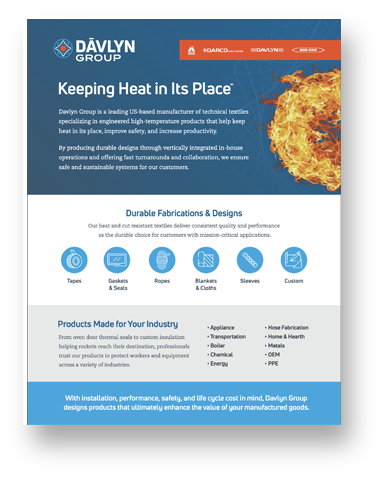Basalt is a volcanic igneous rock found worldwide and has historically been used for architectural casting applications like tiles and slabs and as a concrete aggregate. This type of rock is strong, resistant to abrasion, and highly heat resistant. It has been studied and utilized in several different ways for industrial and military applications, where its wartime applicability was studied extensively in the post-WWII era.
The first patent for basalt fiber manufacturing was issued in 1923 by Paul Dhé, a Frenchman, and has been applied for industrial uses ever since. This strong material can be transformed into thin fibers spun into yarns to reinforce the strength and prepare it for future uses.
Products woven from basalt fiber yarn—such as basalt sleeves, exhaust tape, basalt rope, and basalt window channel gaskets—are very strong, flexible, heat resistant, and recyclable, making them versatile components of high-heat applications that are often preferred over similar materials like fiberglass. Common exhaust insulation uses include heat wrapping to reduce excess heat in passenger vehicles and motorcycles and heat containment to seal hot oven doors.
The History of Basalt Fiber
Basalt fibers have a colorful history due to their military and industrial applicability, which became especially relevant during the Cold War when both United States and Soviet Union officials began investigating the different uses of basalt for military hardware.
Large basalt formations were concentrated in the Northwestern United States, where Washington State University conducted research to understand better basalt fibers’ chemical properties and extraction process and how to expand their applicability. American glass companies like Corning and Owens were also involved in independent research and patent procurement around basalt fibers until the 1970s when basalt fiber research was abandoned to focus on other glass products like S-2 glass or E-glass.
In Eastern Europe, groups in Moscow, Prague, and other Soviet cities conducted their own research post-WWII, which was nationalized by the USSR’s Defense Ministry and concentrated in Kyiv, Ukraine, where basalt research and military products were engineered, tested, and manufactured.
After the fall of the Soviet Union in 1911, research was declassified and made available for public use. Basalt fiber research, for example, has been vital in expanding basalt tape technology.
How is Basalt Fiber Made?
Basalt fiber is like glass fiber and shares similar production processes but with key differences that ultimately make basalt fiber creation easier than glass.
First, raw basalt rock is crushed, washed, separated, and fed into melting baths in high-heat gas furnaces. Unlike glass fiber production, which includes multiple derivatives in addition to silica sand as the main ingredient, basalt fiber is made from a singular basalt material. This streamlines the process of conveying materials into the furnace all at once, unlike glass fiber production, which would require independent metering of each included material before being sent into the furnace. However, one downside of basalt fiber production is that manufacturers have less direct control over the purity and consistency of the raw basalt, so sourcing from a quality quarry is essential.
Crushed basalt then enters the furnace and is liquefied at a temperature of 1500°C/2732°F. Unlike glass, which is transparent, opaque basalt absorbs rather than transmits infrared energy. Therefore, it’s harder for overhead gas burners used in conventional glass furnaces to heat the entire basalt mix uniformly. With overhead gas, the melting basalt must be held in the reservoir for extended periods compared to glass to ensure a homogenous temperature.
Next, basalt filaments are formed by platinum-rhodium bushings, as would happen for glass. As the filaments cool, a sizing agent is applied, and the material is moved to speed-controlled fiber stretching equipment and then winding equipment, where the basalt fiber is spooled for future usage.
Since the basalt filament is more abrasive than glass filaments, bushings need to be replaced more frequently and are expensive. However, modern bushings for basalt fiber production have similar lifecycles to those used in glass production.
After the fiber is produced, it is incorporated into the final product, like exhaust sleeves made from basalt fiber. While this is the most common application for this processed material, another common use is within the home and hearth industry, where ropes or window channel gaskets are utilized.
While basalt fiber production may be more time-intensive and costly than glass production in the final stages, the fibers used for basalt exhaust tapes and sleeves are superior in durability, strength, and longevity in composites and applications requiring extreme temperature protection.
What are the Benefits of Basalt Fiber?
There are several core benefits of basalt fibers that makes this material so industrially applicable.
- Thermal resistance
- Corrosion and fire resistance
- Low water absorption
- Electricity conduction prevention
- UV Resistance
- Electromagnetic radiation resistance
- Acidity resistance
A recent study comparing epoxy glass fibers to basalt fibers made through the same process found that basalt fibers also have:
- Higher tensile modulus
- Higher tensile strength
- Higher interlaminar shear strength
- 40% higher specific strength
- 20% higher specific stiffness
Basalt fiber’s impact resistance sets it apart significantly from glass and carbon. For example, basalt fiber yarn has been observed to have an approximately 35% higher specific energy absorption capacity compared to a similarly structured glass hybrid material and 17% higher capacity compared to similar woven carbon hybrid material.
Basalt is also for worker safety and air quality since the basalt fiber production process is more environmentally safe than glass fiber as a volcanic byproduct. This reduces the greenhouse gases that are emitted in the fiber creation process. Basalt is also an inert, non-combustible material that naturally occurs on Earth, so it is more recyclable than other reinforcing fibers—a factor that automotive and other industries consider.
Choosing Between Basalt & Glass
Unfortunately, even with modern advancements, basalt fiber products are more expensive than similar glass-derived competitors like E-glass. However, the benefits in performance, such as with basalt sleeves, make the increased cost a worthy investment in your product’s performance.
The benefits of basalt fiber over E-glass include better strength, stiffness, impact resistance, corrosion resistance, water resistance, and thermal resistance. These qualities make sleeves, exhaust tapes, ropes, and other materials made from basalt fiber the preferred choice when it comes to thermal protection.
If you’re looking to discover how basalt fiber products can be beneficial for your product or business, reach out to the Davlyn Group today to customize the best solution for your needs.
Sources



